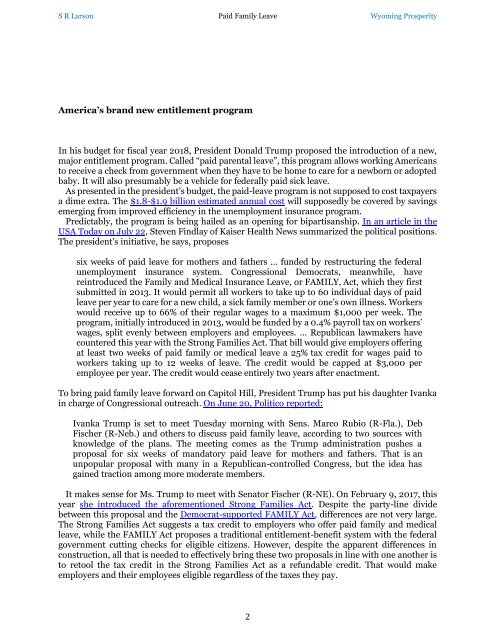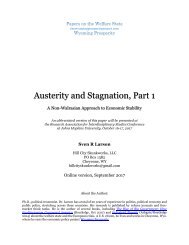Welfare State Paper 1 Paid Family Leave copy
Create successful ePaper yourself
Turn your PDF publications into a flip-book with our unique Google optimized e-Paper software.
S R Larson <strong>Paid</strong> <strong>Family</strong> <strong>Leave</strong> Wyoming Prosperity<br />
America’s brand new entitlement program<br />
In his budget for fiscal year 2018, President Donald Trump proposed the introduction of a new,<br />
major entitlement program. Called “paid parental leave”, this program allows working Americans<br />
to receive a check from government when they have to be home to care for a newborn or adopted<br />
baby. It will also presumably be a vehicle for federally paid sick leave.<br />
As presented in the president’s budget, the paid-leave program is not supposed to cost taxpayers<br />
a dime extra. The $1.8-$1.9 billion estimated annual cost will supposedly be covered by savings<br />
emerging from improved efficiency in the unemployment insurance program.<br />
Predictably, the program is being hailed as an opening for bipartisanship. In an article in the<br />
USA Today on July 22, Steven Findlay of Kaiser Health News summarized the political positions.<br />
The president’s initiative, he says, proposes<br />
six weeks of paid leave for mothers and fathers … funded by restructuring the federal<br />
unemployment insurance system. Congressional Democrats, meanwhile, have<br />
reintroduced the <strong>Family</strong> and Medical Insurance <strong>Leave</strong>, or FAMILY, Act, which they first<br />
submitted in 2013. It would permit all workers to take up to 60 individual days of paid<br />
leave per year to care for a new child, a sick family member or one’s own illness. Workers<br />
would receive up to 66% of their regular wages to a maximum $1,000 per week. The<br />
program, initially introduced in 2013, would be funded by a 0.4% payroll tax on workers’<br />
wages, split evenly between employers and employees. … Republican lawmakers have<br />
countered this year with the Strong Families Act. That bill would give employers offering<br />
at least two weeks of paid family or medical leave a 25% tax credit for wages paid to<br />
workers taking up to 12 weeks of leave. The credit would be capped at $3,000 per<br />
employee per year. The credit would cease entirely two years after enactment.<br />
To bring paid family leave forward on Capitol Hill, President Trump has put his daughter Ivanka<br />
in charge of Congressional outreach. On June 20, Politico reported:<br />
Ivanka Trump is set to meet Tuesday morning with Sens. Marco Rubio (R-Fla.), Deb<br />
Fischer (R-Neb.) and others to discuss paid family leave, according to two sources with<br />
knowledge of the plans. The meeting comes as the Trump administration pushes a<br />
proposal for six weeks of mandatory paid leave for mothers and fathers. That is an<br />
unpopular proposal with many in a Republican-controlled Congress, but the idea has<br />
gained traction among more moderate members.<br />
It makes sense for Ms. Trump to meet with Senator Fischer (R-NE). On February 9, 2017, this<br />
year she introduced the aforementioned Strong Families Act. Despite the party-line divide<br />
between this proposal and the Democrat-supported FAMILY Act, differences are not very large.<br />
The Strong Families Act suggests a tax credit to employers who offer paid family and medical<br />
leave, while the FAMILY Act proposes a traditional entitlement-benefit system with the federal<br />
government cutting checks for eligible citizens. However, despite the apparent differences in<br />
construction, all that is needed to effectively bring these two proposals in line with one another is<br />
to retool the tax credit in the Strong Families Act as a refundable credit. That would make<br />
employers and their employees eligible regardless of the taxes they pay.<br />
2



